Exploring Frog Tape Width for Painting and Crafting
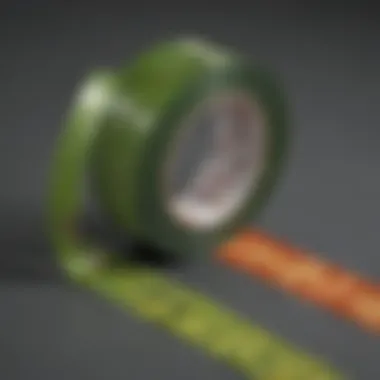
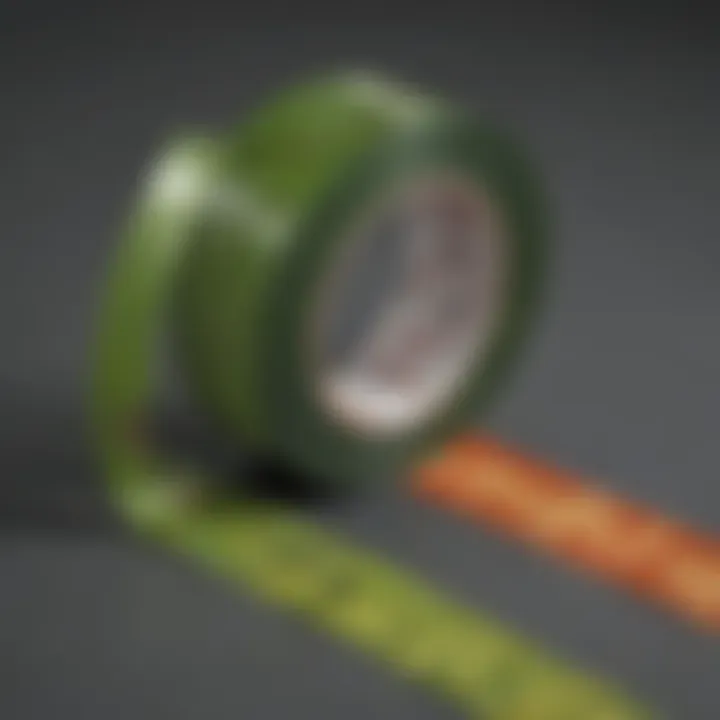
Intro
In the world of home improvement, even the smallest tools can make a big difference. One such tool that has gained considerable attention is Frog Tape. Known for its unique features and capabilities, it plays a crucial role in various projects, particularly in painting and crafting. This tape comes in various widths, each tailored for specific tasks, which means selecting the right one can profoundly impact the outcome of your project.
Understanding the significance of frog tape width is essential for anyone looking to achieve professional-looking results in their home. The importance lies not just in the aesthetic appeal but also in the efficiency and precision that the right tape can provide. A well-chosen width can make the difference between a clean line and a paint bleed, saving time and materials.
For homeowners, the choices might feel overwhelming. With many options available, understanding the nuances can empower decision-making, ensuring the best results are achieved without unnecessary frustration. This article will explore frog tape width and its broader implications in various projects, guiding you from the initial planning stages all the way through to celebrating your final results.
The Significance of Tape Width in Practical Applications
Understanding the significance of tape width is key for anyone diving into painting or crafting projects. When you choose the width of the tape, you’re not just making a simple decision; you’re setting the stage for the entire outcome. A tape’s width can affect precision, ease of use, and ultimately, the quality of the finish. Choosing the right width isn’t merely a matter of preference but can make the difference between a tidy job and a frustrating mess.
When it comes to Frog Tape, the width can take center stage. It’s designed to perform well in various tasks, from intricate DIY crafts to larger painting jobs. Its special edge technology helps create razor-sharp lines, making width intrinsically linked to precision.
Now, consider how tape width plays a role in specific benefits. For instance, wider tapes may cover more area quickly, perfect for blocking off large sections. On the flip side, narrower tapes afford greater control, suitable for delicate designs or edges. So, the significance of tape width transcends simple measurements; it situates the user closer to their project goals.
"The right tape width is like the right brush stroke: it can mean the difference between art and chaos."
Using the wrong width can lead to overspill, messy edges, or unnecessarily long clean-up times. It becomes clear that understanding your project’s requirements plays a critical role in selecting the appropriate tape width.
Understanding Frog Tape
To appreciate why tape width matters, one must first understand what Frog Tape is and what sets it apart from other options. Frog Tape specializes in delivering clean and crisp lines due to its unique formulation. This painter’s tape has unique properties that enable it to seal edges, preventing paint bleed and ensuring the project maintains a professional appearance.
Frog Tape comes in various widths, catering to different applications. Whether it’s a wide roll to cover a large wall surface or a narrow strip for detailed edge work, you will find a Frog Tape that fits the task at hand. Choosing the appropriate width while using Frog Tape ensures both ease during application and quality in results.
In practice, understanding the makeup of different widths can aid decision-making, impacting everything from the ease of application to the type of finish one aims for.
Defining Width in the Context of Tape Usage
Width, as it relates to tape usage, refers to the measurement across the adhesive surface of the tape. This measurement can significantly impact how the tape performs under various conditions. For instance, a two-inch wide tape may be best for broad surfaces, while half-inch options cater to more delicate procedures, like stenciling or creating intricate designs.
Different width options can meet specific needs. Here’s how they break down:
- Wider widths (1.5 to 2 inches) are ideal for large, flat surfaces, providing ample coverage and speed in application. They suit projects requiring extensive masking, like wall painting.
- Medium widths (1 inch) strike a balance, allowing both coverage and precision. They can be used in a variety of projects and are a versatile option.
- Narrow widths (0.5 inches or less) cater to fine details or tight spaces. They are perfect for artistic designs, crafts, or trimming when a higher degree of control is necessary.
Ultimately, defining the width of Frog Tape not only helps in practical application but in elevating the overall quality of the project. The selection reflects the user's understanding of both the task and the materials at hand, enhancing the likelihood of a successful outcome.
Diversity of Available Frog Tape Widths
In the world of painting and home projects, the width of tape can play a pivotal role. Frog Tape, known for its superior performance, offers a variety of widths tailored to different tasks. Understanding this diversity is not only helpful for DIY enthusiasts but also essential for professionals aiming for perfect results. When one decides to tackle a painting job, the choice of width can greatly influence the accuracy, ease of application, and overall finish.
Standard Widths: An Overview
Standard widths of Frog Tape typically range from 0.94 inches up to 1.5 inches. These sizes are well-suited for most average tasks, such as painting interior walls or general crafts. The 0.94-inch tape can deftly navigate around smaller edges or intricate designs, making it a favorite among those involved in fine detail finishes.
Using these standard widths can also prevent over-application of paint, which in turn reduces the risk of bleed-through. An example being, when painting a wall while needing to cover trim work, using a 1.5-inch tape can shield the trim effectively from splashes, thus saving time on cleanup later. Standard widths are like the trusty friends in your toolkit—they're always there when you need a helping hand.
Wider Options: When to Consider
Consider widening your choice when tackling bigger projects. Wider options, such as 2 inches or even larger, can be found among Frog Tape offerings. Such tape widths are invaluable for expansive surfaces where speed and efficiency are key. For instance, if one is working on exterior painting or a quick touch-up on broad areas, using wider tape like 2 inches allows for quicker application, ensuring larger sections are masked off more rapidly.
Additionally, these widths provide more coverage, which means less time spent aligning and adjusting. When working on larger surfaces, it is often simpler to achieve sharp lines without needing to make multiple passes with narrower widths.
"In projects where efficiency is paramount, sometimes size does matter."
Narrow Widths: Specific Use Cases
Narrow widths have their cool charm, particularly in specialized tasks. For example, widths of 0.3 inches or less can be perfect for intricate stencil work or delicate touch-ups. These slim strips provide the flexibility needed to maneuver around delicate shapes and edges without overwhelming the space.
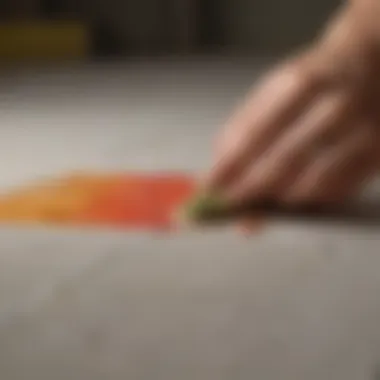
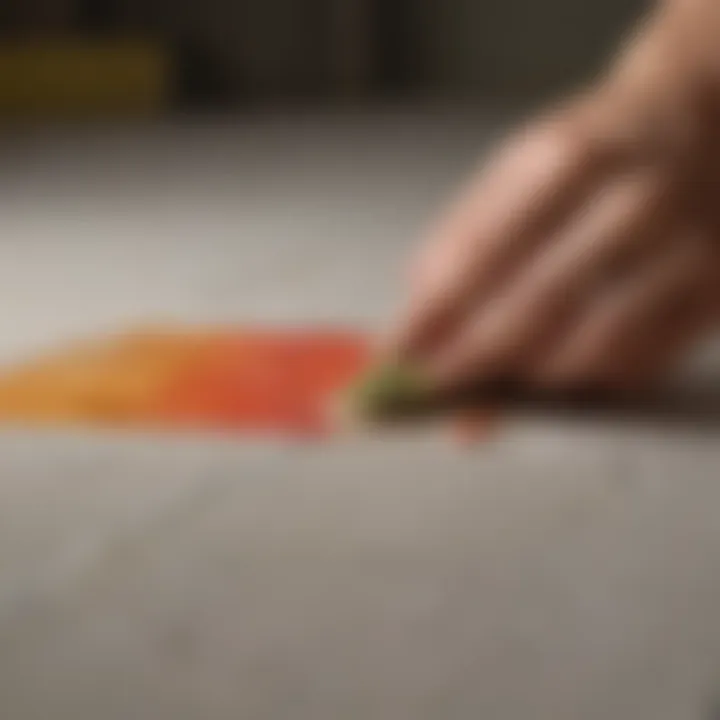
If you are a fan of personalized decor—maybe stenciling a delicate design or creating a sophisticated mural, these narrow options can align well with your aspirations. Their narrow design means they take up less surface area, offering tighter control and preventing paint bleed that might ruin painstakingly crafted details. Narrow widths can even help with blending colors seamlessly in artistic endeavors without creating harsh lines.
While exploring the diversity of available Frog Tape widths, it becomes clear that the right choice hinges on the specifics of the task at hand. Each width has its benefits that can make or break the success of a project. Considering project size, complexity, and desired finish can lead to more informed decisions, ultimately creating more satisfying results.
Evaluating the Benefits of Specific Tape Widths
When it comes to Frog Tape, width isn't just a number on a roll. It's a game-changer that can profoundly influence the outcome of your painting and crafting projects. The right tape width can provide you with precision, reduce cleanup time, and offer superior adhesion and sealing capabilities. In this section, we delve into these crucial benefits, illustrating why selecting the appropriate width is a decision of great significance.
Precision in Painting
Choosing the right width of Frog Tape can ultimately determine the crispness of those lines while painting. Think about it: a broader tape might seem like a good idea when attempting to cover large areas quickly, but it can often lead to messy edges that ruin the aesthetic appeal of a project. On the other hand, narrow widths allow for meticulous painting, enabling an artist to create intricate designs without the paranoid fear of overspray.
Consider the scenario of painting a living room wall with a detailed border. Using a narrow Frog Tape, approximately half an inch, allows you to place the tape precisely along the line, giving you the confidence to achieve clean strokes without worrying about bleed-through.
Furthermore, different projects may require varying sizes of tape for optimal results. For instance, when working on small crafts, a quarter-inch tape may be more suitable to navigate curves and tight corners, ensuring that your artistic vision comes to life flawlessly.
Reducing Cleanup Time
Nothing is more frustrating than spending your evening enjoying a freshly painted room only to find out the clean-up is going to drag on. Utilizing the right tape width can significantly decrease the amount of time you spend scrubbing off paint from unintended surfaces. When you employ wider tape for longer surfaces, the risk of paint seeping underneath is reduced; a swift pull on the tape at the right moment means less mopping up afterward.
A common mistake is to skimp on tape, feeling that thin strips will suffice. However, this can lead to excess paint on unintended areas, prompting time-consuming clean-ups. Instead, using a one-and-a-half-inch tape width to cover wider areas can save you from double work – a win-win if there ever was one.
In short, the correct tape width not only streamlines your project but also keeps your spirits high, leaving you more time to pour that well-deserved glass of wine instead of scrubbing the floor.
Enhanced Adhesion and Sealing
The adhesive qualities of Frog Tape are among its greatest attributes, and these can be maximized through the right width selection. Wider tapes ensure better adhesion to the surface, creating a tighter seal that prevents paint from sneaking in where it shouldn’t. This is particularly beneficial for rough or textured surfaces where a narrower tape might struggle to maintain contact, leading to potential gaps.
Moreover, the specific formulation of Frog Tape's adhesive reacts with the paint, which can only do its magic if applied correctly. A narrower tape could lead to uneven pressure, making it less effective in holding the surface against paint migration. Whether you’re working with latex or oil-based paints, the assurance of a solid stick gives peac of mind and enhances the finished look.
"Using the right width of Frog Tape can be the difference between a project that looks like a masterpiece and one that requires a series of do-overs."
Comparative Analysis of Frog Tape versus Other Tapes
In any painting project, choosing the right tape can make all the difference. Specifically, Frog Tape has carved a niche for itself in the world of masking tapes. This section delves into how it stacks up against other popular options, including blue painter's tape and standard masking tape. Understanding these comparisons can help homeowners and DIY enthusiasts select the best tool for their specific tasks.
Frog Tape vs. Blue Painter's Tape
Blue painter's tape is a household name in the realm of home improvement and painting. While both it and Frog Tape serve the same basic function—to create clean, sharp lines while paint dries—there are distinct differences that affect performance. Frog Tape employs a patented PaintBlock technology that, upon contact with moisture, expands to seal the edges, which aids in preventing paint bleed. This quality often leads to more professional-looking results, especially on intricate surfaces.
On the other hand, blue tape is easier to position initially since it has a slightly less aggressive adhesive, which makes it friendly for delicate surfaces. However, the trade-off can be more paint bleed, especially when used on fresh paint or uneven textures. For delicate projects where precision is paramount, Frog Tape's unique sealing ability generally earns the top spot.
Frog Tape vs. Masking Tape
Masking tape is the old reliable of the tape world—often a go-to choice for many DIYers and professionals alike. However, it lacks the sophisticated technology found in Frog Tape. Regular masking tape typically doesn’t seal the paint edges effectively, resulting in more smudging and fuzzing of paint lines. Plus, the adhesive isn't as finely tuned for paint preparation, which can lead to surface damage if removed prematurely.
However, in terms of cost-effectiveness, masking tape tends to be cheaper, making it a tempting option for large, uncomplicated jobs. A good strategy might be to use masking tape for sections that won't be viewed closely, while reserving Frog Tape for the areas that require a polished finish.
Evaluating Specialist Tapes
There’s a whole world of specialized tapes out there, perfect for unique needs that Frog Tape and its counterparts might not cover. Specialty tapes, such as those designed for delicate surfaces, waterproof applications, or even those tailored for textured surfaces, can be invaluable depending on the project.
For instance, some tapes are crafted specifically for outdoor use, with UV-resistant properties that prevent fading and peeling. Others cater to glass or painted surfaces where additional precision is necessary.
"Choosing the right tape requires an understanding of the specific needs of your project. By comparing your options thoroughly, you can ensure long-lasting results and a professional finish."
Practical Considerations When Choosing Tape Width
When it comes to utilizing Frog Tape, a tape's width can greatly influence the outcome of your project. Choosing the right width hinges on several factors including the type of project, the scale of the work, and the surfaces involved. Incorrect choices can lead to unnecessary touch-ups or even complete redo of your work. This section delves into the essential aspects to evaluate when deciding on tape width, ensuring that your projects don’t turn into a case of ‘measure twice and cut once’ without proper judgment on tape choice.
Assessing Project Type and Scale
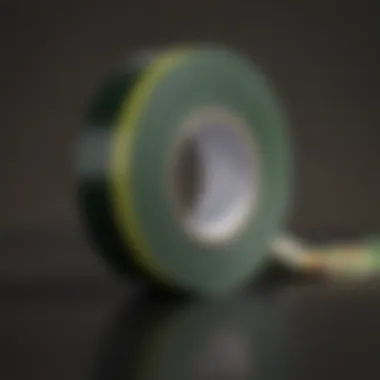
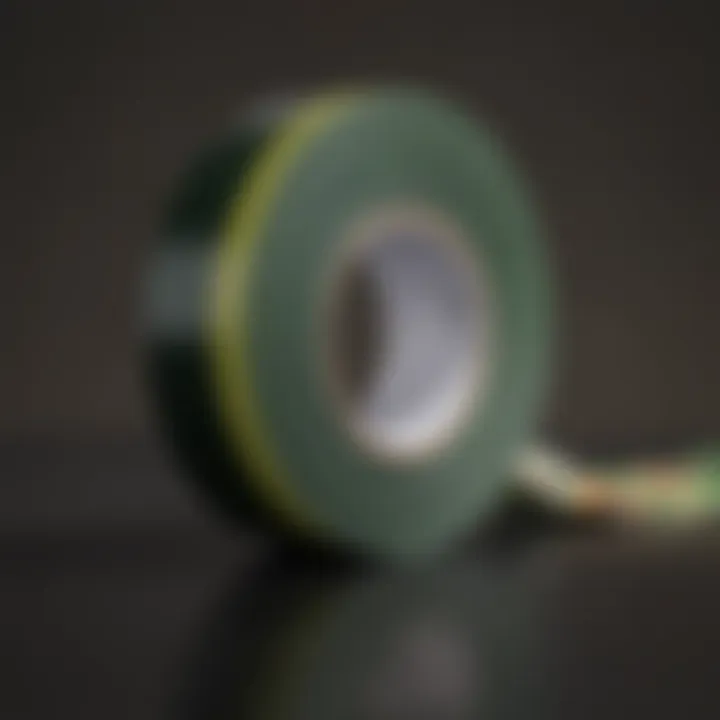
The type of project you’re engaging in plays a significant role in determining the appropriate tape width. For instance, when working on fine details like intricate trim or delicate accents, a narrow width, perhaps half inch, is often preferable. This allows for precise lines, providing a clean finish that would otherwise be overshadowed by a broader tape.
In contrast, larger spaces, such as walls or fences, where the surface area is expansive, employing wider tape might make more sense. The greater surface coverage speeds up the task while ensuring consistent edges.
Here are some practical considerations for assessing project type and scale:
- Detailed Paintwork: Use narrow tape for complex patterns or small areas to achieve sharp lines.
- Large Wall Sections: Opt for a wider tape to cover more area quickly.
- Furniture Refinishing: Depending on the detail work, either might be suitable depending on the intricacy.
Understanding the scale of your work can not only save time but also enhance the overall aesthetic. Less clean-up and fewer layers of paint to manage streamline the process, making the experience more enjoyable.
Surface Texture and Tape Compatibility
Another crucial element that influences tape width selection is the texture of the surfaces you are working with. Different surfaces react uniquely to tape adhesion. For instance, smoother surfaces generally allow for wider tape because they create an even seal, preventing paint from seeping underneath. On the other hand, textured surfaces, such as stucco or uneven wood, require narrower widths for better control of paint application and to minimize the risk of bleed-through.
Here are a few key points regarding surface texture and tape compatibility:
- Smooth Surfaces: Wide tape can effectively cover large areas, suitable for drywall or flat panels.
- Rough or Textured Surfaces: Narrow tape is better, allowing for precise placement without risking paint bleed.
- Follow with a Test Area: No matter the surface, always consider testing with a small piece of tape first to gauge effectiveness before committing.
Ultimately, understanding how your chosen Frog Tape interacts with various materials can save you a lot of headaches down the line. Not only do you avoid it sticking to surfaces where it shouldn’t, but you also enhance the likelihood of achieving flawless results.
"Selecting the right tape width can be the difference between a thriving project and a disaster waiting to happen."
Aligning the type and scale of the project with the surface texture ensures that you are setting the stage for optimal results. Taking these practical considerations into account paves the way for a successful painting or crafting experience.
Techniques for Effective Application
Applying Frog Tape effectively requires more than just slapping it on surfaces; it's an art in its own right. Knowing how to prepare your workspace, place the tape correctly, and apply the right amount of pressure contributes significantly to achieving clean, crisp lines in your painting or craft projects. These steps ultimately lead to a professional-looking finish that enhances the overall aesthetic of your work.
Preparing the Surface
Before even thinking about tape placement, a proper surface preparation is crucial. You wouldn’t bake a cake on a dirty pan, right? The same logic applies here. Clean surfaces allow for better adhesion and minimize the risk of any mishaps. Dirt, dust, or grease can compromise the effectiveness of the tape.
- Clean Thoroughly: Wipe down surfaces to remove dust and any residues. A simple mixture of mild soap and water can do the trick.
- Drying: After cleaning, ensure the surface is completely dry before applying the tape. Wet or damp surfaces can cause the tape to peel off or not adhere at all.
- Sanding: For rough or uneven surfaces, light sanding can be helpful. This creates a smoother area for the tape to cling onto.
A well-prepped surface renders a solid foundation for the subsequent steps, leading to better outcomes overall.
Proper Tape Placement
Now that the surface is clean and dry, the next step is all about placement. Improper tape placement may result in uneven lines or bleed-through, which no one wants to deal with after a long painting session.
- Alignment: Ensure the tape is straight and positioned where you want your paint division to be. An easy trick is to use a level or even a string stretched tightly along your desired line.
- Pressing Down: After laying the tape down, use a putty knife or a similar tool to press down the edges. This helps create a solid seal and prevents paint from sneaking underneath.
- Avoid Stretching: Be careful not to stretch the tape while applying. Stretching can lead to uneven lines and also affect the adhesion.
Taking time with tape placement pays off. A small moment of care can prevent hours of frustration later.
Timing and Pressure for Optimal Results
Timing and pressure are sometimes the unsung heroes in the world of tape applications. Knowing when to apply paint and how hard to press can make or break your project.
- Application Timing: Wait for the right moment to paint. Ideally, you should paint shortly after applying the tape while the adhesive is setting but before it fully bonds to the surface. This timing is crucial for keeping lines sharp.
- Pressure during Painting: When rolling or brushing paint, apply steady and moderate pressure. Too much pressure can lift the tape leading to those unwanted paint bleed-throughs.
"The finest results stem not just from quality materials, but from careful application techniques."
Ultimately, mastering these techniques will significantly elevate the quality of your painting efforts. Each step, from surface preparation to proper tape placement and judicious timing, works in harmony to achieve that desired polished finish.
Common Mistakes to Avoid When Using Frog Tape
When diving into the world of Frog Tape, it’s easy to overlook a few essential details that can make or break your project. The common mistakes that often arise during usage can lead to unsatisfactory results, wasting both time and effort. Understanding these pitfalls is crucial for achieving crisp, clean lines and ensuring an overall polished finish in your painting endeavors. By being aware of these frequent missteps, you can sidestep potential frustrations while enhancing the effectiveness of your tape application.
Insufficient Surface Preparation
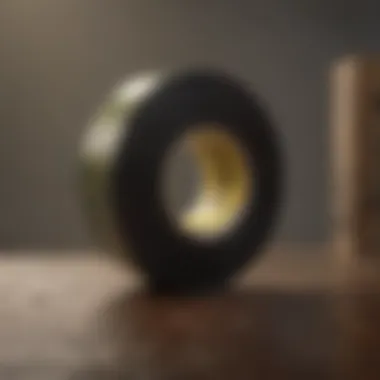
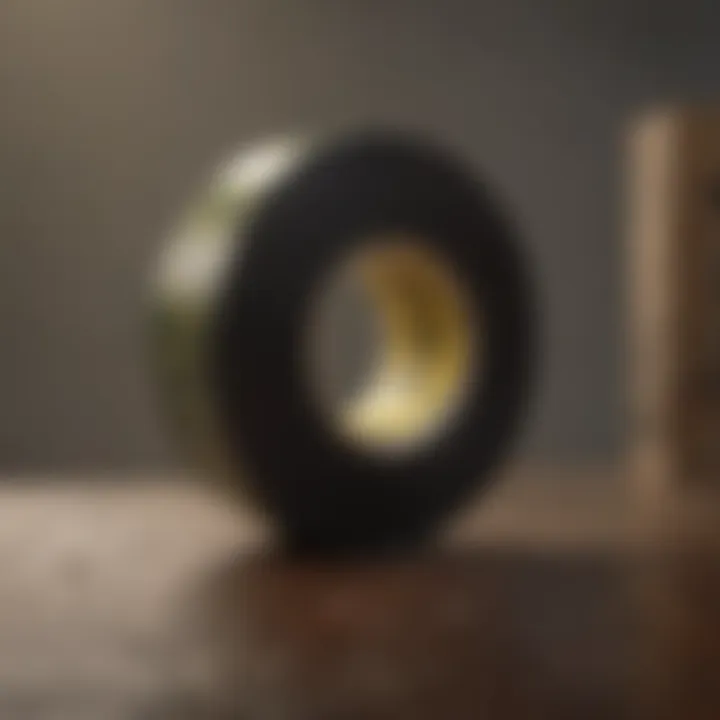
Properly preparing the surface before applying Frog Tape can't be emphasized enough. Many people shortcut this process, thinking that a quick wipe down will suffice. But let me tell you, just like a chef wouldn’t dream of throwing a meal together without prepping ingredients, you shouldn't think of taping without a solid surface preparation.
A clean and smooth surface helps the tape adhere properly, allowing for crisp edges without paint bleeding underneath. Always remove dust, dirt, or oil with a damp cloth, or use a gentle cleaner designed for surfaces you'll be painting. Even a kitchen sponge used carelessly can leave behind residue that can ruin your tape's effectiveness. If you've got textured or uneven walls, that’s another ballgame entirely. You might need to apply primer, or at the very least, fill in any cracks with spackle to ensure the tape holds fast.
Incorrect Width Selection
Choosing the right width of Frog Tape can feel a bit daunting given the variety available. However, opting for a width that doesn’t fit your specific needs can lead to unnecessarily poor results. For smaller projects, like touch-ups or intricate designs, a narrower width is usually more suitable, while larger areas typically call for a standard or wider tape.
One might think, "More tape means better coverage," but that isn’t always the case. A tape that is too wide for detailing can result in paint on unwanted areas, leading to messy lines that defeat the purpose of using tape in the first place. Additionally, if you’re addressing more profound textures, like rough wood or stucco, wider tape helps cover larger inconsistencies, resulting in cleaner lines. Take a moment to assess your project requirements before reaching for that roll. It could save you a headache down the road.
Neglecting Removal Timing
Ah, the removal timing of Frog Tape is one component often underestimated. Once your paint is dry to the touch, the immediate urge might be to rip off the tape, revealing the masterpiece beneath. But patience is truly a virtue here. Pulling the tape off too early can smudge your paint job, whereas waiting too long - especially with latex paints - can lead to the tape taking with it some of the paint you just carefully applied.
The best practice is to remove Frog Tape when the paint is just set but still slightly tacky, often within an hour or so. Pull it off at a 45-degree angle, guiding it away from the painted surface. This method minimizes the risk of damaging your hard work. Remember, good results don’t just happen; they require time and a touch of foresight.
Proper surface prep, careful width selection, and getting the removal timing just right can transform your painting experience. Every detail counts, after all!
Consumer Preferences and Trends in Tape Widths
In a world where home improvement projects are as common as Sunday brunch, understanding consumer preferences and trends regarding tape width is both useful and insightful. When house owners and DIY enthusiasts step into the paint aisle, they aren’t just looking for any tape; they are often hunting for products that cater to their specific needs, be it precision, ease of use, or even aesthetics. As the web of options expands, so does the significance of choosing the right tape width and, evidently, the preferences of the consumers.
Surveying User Satisfaction
When it comes to user satisfaction, feedback from those who have actually wielded Frog Tape often speaks volumes. A survey can reveal a lot about what makes a specific tape brand appealing. For instance, many users will emphasize the practicality of wider tape for large projects when painting walls, while they suggest narrower widths for detailed work, like trim and edges.
This feedback underscores a few crucial points:
- Ease of Use: Many find that wider tapes can sometimes be unwieldy, especially for those not as adept with tools. On the flip side, narrow tape tends to provide more control, allowing for better results in tight spaces.
- Quality of Finish: Users consistently report a better finish with Frog Tape compared to generic brands. The variety in width allows them to select a size best suited for their project, contributing to overall satisfaction.
- Durability: The durability of the adhesive plays a key role. Customers note that regardless of width, the longevity of the bond and its ability to prevent paint bleed is paramount to their satisfaction.
"Choosing the right tape width is half the battle!" - A passionate DIY enthusiast
Emerging Trends in Home Improvement
As the landscape of home improvement evolves, so do the preferences of consumers regarding tape widths. These trends not only reveal what is fashionable in the moment but also reflect a shift in consumer lifestyles and their growing awareness of quality over quantity.
Some emerging trends include:
- Customization: More brands are offering custom tape widths, recognizing that not all projects are created equal. Homeowners prefer to select a tape that matches their work style.
- Eco-Friendly Options: There is a marked increase in demand for environmentally friendly tape options. Many consumers are leaning towards products that minimize waste and are made with sustainable materials.
- Online Reviews and Recommendations: Modern homeowners are increasingly relying on social media, forums like Reddit, and user reviews to guide their decisions. This trend highlights how important community feedback is today in shaping consumer choices.
- Expansion in Crafting Uses: With the rise of home crafting activities, many are using Frog Tape not just for painting, but for decorative projects too. Thus, the width selections are becoming tailored not only for paint jobs but also for craft purposes.
The Impact of Technology on Tape Development
The realm of tape manufacturing has experienced significant advancements over the years, mainly driven by technology. These innovations have transformed not only the materials used in making tape but also how they perform in practical applications. When it comes to Frog Tape, understanding the impact of technological progress is essential. In this section, we will explore how technology influences the development of tape, particularly focusing on its adhesive technologies and future manufacturing directions.
Innovations in Adhesive Technologies
Adhesive technology has fundamentally changed the landscape of painting and crafting. Traditional adhesives often came with limitations, such as inadequate bonding strength or difficulty in clean removal. However, companies have developed specialized adhesives that cater to specific surfaces and usage conditions.
For instance, Frog Tape employs a patented Paint Block Technology designed to react with the water in latex paint. This technology helps to form a barrier between the tape and paint, reducing seepage and ensuring clean lines. This innovation caters especially to home improvement enthusiasts who seek precision when it comes to wall art or intricate designs.
Moreover, advancements in adhesives have led to different formulations that allow for better performance under various environmental conditions. This means that whether it’s a humid bathroom or a sunlit living room, the tape adheres reliably. Key benefits of these advancements include:
- Greater Adhesion: Improved bond strength leads to fewer failures during application.
- Easy Removal: Newer adhesives peel away cleanly without removing paint or damaging surfaces.
- Velcro-Like Performance: Some tapes can stick well yet allow for repositioning, giving users flexibility during their projects.
In essence, these innovations enable an effortless and clean painting experience, which is especially cherished by housewives and homeowners aiming to maintain aesthetic appeal.
Future Directions in Tape Manufacturing
Looking ahead, the future of tape manufacturing is poised for further evolution. With the rising demand for sustainable products, manufacturers are exploring eco-friendly materials. Many homeowners are increasingly concerned with their environmental footprint, and the tape industry is responding.
Potential future developments may include:
- Biodegradable Materials: Research is underway to develop tapes that break down naturally, reducing landfill contributions.
- Smart Tapes: Imagine a tape that can change its width or adhesion strength based on the surface or the pressure applied; this technology could revolutionize how we think about adhesive products.
- Enhanced User Customization: Technologies that allow for user-defined widths or patterns on demand could come into play, letting individuals create bespoke solutions for unique projects.
As we progress, it's clear that the marriage of technology and tape manufacturing will offer consumers unprecedented options. The advent of these innovations not only enhances usability but also aligns with modern values around sustainability and customization.
The melding of innovation and functionality in tape technology exemplifies a shift towards more thoughtful consumer products.
With this focus on enhancing user experience and reducing our environmental impact, the future holds promise for both those who craft at home and those embarking on larger projects.







